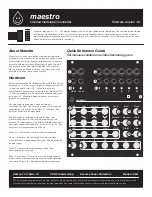
This can also be done in a single piped command:
%
echo cmplt 7 | gmap brol.grf - /tmp/brol.map
If compressed data handling is enabled, read the graph as a
gzip
compressed
file, and output the mapping as a
bzip2
file, on the fly:
%
echo cmplt 7 | gmap brol.grf.gz - /tmp/brol.map.bz2
•
Partition source graph
brol.grf
into two uneven parts of respective weights
4
11
and
7
11
, and save the result to file
/tmp/brol.map
.
%
echo cmpltw 2 4 7 > /tmp/k2w.tgt
%
gmap brol.grf /tmp/k2w.tgt /tmp/brol.map
This can also be done in a single piped command:
%
echo cmpltw 2 4 7 | gmap brol.grf - /tmp/brol.map
If compressed data handling is enabled, use
gzip
compressed streams on the
fly:
%
echo cmpltw 2 4 7 | gmap brol.grf.gz - /tmp/brol.map.gz
•
Map a 32 by 32 bidimensional grid source graph onto a 256-node hypercube,
and save the result to file
/tmp/brol.map
.
%
gmk m2 32 32 | gmap - tgt/h8.tgt /tmp/brol.map
•
Build the
Open Inventor
file
graph.iv
that contains the display of a
source graph the source and geometry files of which are named
graph.grf
and
graph.xyz
.
%
gout -Mn -Oi graph.grf graph.xyz - graph.iv
Although no mapping data is required because of the “
-Mn
” option, note the
presence of the dummy input mapping file name “
-
”, which is needed to
specify the output visualization file name.
•
Given the source and geometry files
graph.grf
and
graph.xyz
of a source
graph, map the graph on a 8 by 8 bidimensional mesh and display the
mapping result on a color screen by means of the public-domain
ghostview
PostScript previewer.
%
gmap graph.grf tgt/m8x8.tgt | gout graph.grf graph.xyz
’-Op
{
c,f,l
}
’ | ghostview -
•
Build a 24-node Cube-Connected-Cycles graph target architecture which will
be frequently used. Then, map compressed source file
graph.grf.gz
onto it,
and save the result to file
/tmp/brol.map
.
%
amk ccc 3 | acpl - /tmp/ccc3.tgt
%
gunzip -c graph.grf.gz | gmap - /tmp/ccc3.tgt /tmp/brol.map
128








































